 2002 2002
The Space In Between
Between ‘before’ and ‘after’ there is a space – the space in
between. When a parent goes to prison, the effects on children
are traumatic, infiltrating every part of their lives.
Directed by Rebecca Barry of the Australian Film,
Television and Radio School, this documentary explored
the instability, alienation and social discrimination that
families and their children experience when a parent is
incarcerated.
The law is that you can only take
into account the effect on children in the most
exceptional circumstances.
Judges have been counselled to be very careful not to become over-sympathetic in sentencing prisoners bearing in mind that they have
dependent children.
There’s not much compassion in the world today – it’s all an eye for
an eye and a tooth for a tooth and demands that judges sentence
prisoners to greater and greater terms of imprisonment.
I observed the turmoil and the distress on children when their father
or mother was being sentenced. I felt quite deeply that they were the
neglected part of the population. No one seemed to worry too much
about what happened to them, and that motivated me to speak out at
the time of my retirement because it did affect me a great deal.
– Peter McInerney, QC, retired Supreme Court Judge,
interviewed on The Space In Between
Bathurst expands its reach
This year a grant was received from Department of Community Services to expand
services and provide outreach services to children and families. Initially this is
established in a rented office in the Bathurst Aboriginal Lands Council, however in
2004 the Bathurst Correctional Centre would provide a new operational venue to
be shared with Justice Health, located in Vittoria Street, a short distance from the
prison.
2001
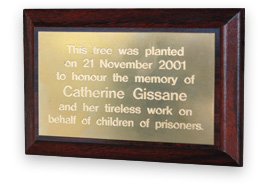 Our first bequest Our first bequest
COPSG was barely established when Cath
Gissane read an article in her local paper
which moved her to volunteer.
Over the next 17 years, she took children to
visit their parents in jail, served as a member
of the management committee and was a
formidable advocate.
Using only public transport, she covered the state with her charges. Grafton,
Cessnock, Goulburn ... nowhere was too far, no child too demanding, no problem
too difficult to solve. She could always be relied on to provide support and
encouragement to workers, volunteers and clients and was well loved in return.
Cath was not a wealthy woman; she brought up her three children alone on a war
widow’s pension. Yet when she passed away in 2001, she left $10,000 to SHINE – our first bequest.
We named the Cath Gissane Child Care Centre at the Silverwater Complex in her
honour.
14,500 children with a parent in prison
Simon Quilty’s research showed that, during 2001 in NSW, 14,500 children had a
parent in prison. Of these, 2250 were left without their mother.
60% were under five years of age when they experienced a parent being
incarcerated for the first time.
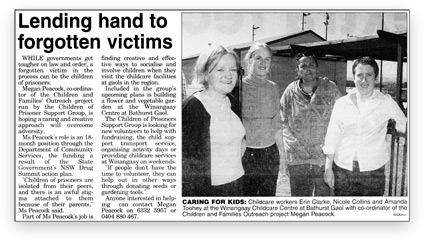
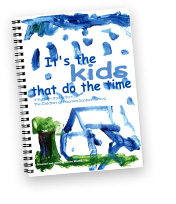 It’s the kids that do the time It’s the kids that do the time
Compiled by Denise Blackett, this book shares the
many stories from the volunteers about their time at
SHINE for Kids.
The volunteers – who give their time
freely without asking for anything in
return – describe
how their experience has a remarkable positive
influence on their lives.
It’s the kids that do the time was funded by The
Department of Family and Community Services
Small Grants Projects to commerate the International
Year of the Volunteer 2001.
2000
SHINE for Kids opens in Bathurst
Many families follow an incarcerated parent, sometimes from jail to jail. This, of
course, adds to a child’s feeling of isolation and dislocation – especially as fellow
students will have a good idea of why they have suddenly appeared in class.
In Bathurst, teachers reported that children of prisoners were turning up for school
hungry on Monday mornings – food restrictions in prison meant they rarely ate
proper meals during weekend visits. Feuds ignited in the boring and claustrophobic
prison environment were exploding in the playground.
Although a pilot Child & Family Centre program had been trialled at Bathurst
in 1998, prison renovations had left us without an onsite operational base.
ATSIC granted funding in 1999 for the construction of a building adjacent to the
prison which in 2000 opened as our Child and Family Centre Bathurst.
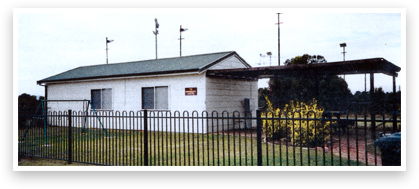
1997
The Parliament of NSW Legislative Council Standing
Committee on social issues released a report into
children of imprisoned parents
Key conclusions:
- A sentence of imprisonment on a primary carer of children should only be imposed where all possible alternatives have been exhausted. The courts should always seek community-based alternatives, particularly in the case of offenders who have committed non-violent offences.
- Data on the number of parents in prison and on the number of children who have parents in prison should be maintained to ensure that
effective policies and strategies are developed for these children.
- Effective pre- and post-release services that have as a focus family
support and re-unification should be properly resourced and
available throughout New South Wales.
Construction and renovation at Silverwater
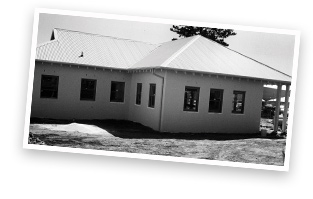 Since 1992 we’d watched
the area around Silverwater
Correctional Centre change – even losing a storage shed to the
widening of the Holker Street.
Major General Smethurst, Commissioner of Corrective
Services was instrumental in the construction of a new
Child & Family Centre which began in 1996. When this was completed in 1997
SHINE for Kids temporarily moved its operations into this building while The
Cottage was renovated in sympathy with its original Federation heritage. Since 1992 we’d watched
the area around Silverwater
Correctional Centre change – even losing a storage shed to the
widening of the Holker Street.
Major General Smethurst, Commissioner of Corrective
Services was instrumental in the construction of a new
Child & Family Centre which began in 1996. When this was completed in 1997
SHINE for Kids temporarily moved its operations into this building while The
Cottage was renovated in sympathy with its original Federation heritage.
Ten years on, Commissioner Ron Woodham of the
Department of Corrective Services would also see the
difference made by having a supportive place for children
and families to drop into, and enabled the establishment of the Child & Family Centre at Windsor and in 2007
supported the expansion of SHINE for Kids to Wellington, Cessnock and Parklea.
1994
Family Day ‘94
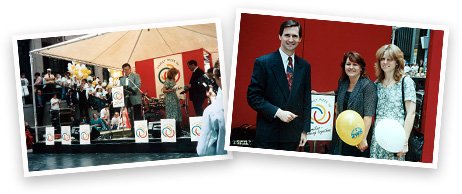
As part of the International Year of
the Family Demonstration Projects Program, funding was presented to COPSG by
The Hon. Jim Longley MP at a ceremony in Martin Place. It established a pioneering
program in which fathers and their children could spend time together outside normal visiting conditions – an opportunity previously granted only to inmate mothers.
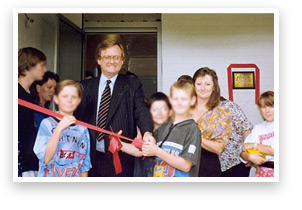 1992 1992
A big 10th birthday present
As COPSG celebrated ten years, we moved into new premises, ‘The Cottage’, at Silverwater
Correctional Centre. The
ribbon was cut by the
Hon. Wayne Merton, then
NSW Minister for Justice,
with the help of Matthew,
James and Chad Bales on
22 December 1992.
1989
Addison Road Community Centre, Marrickville
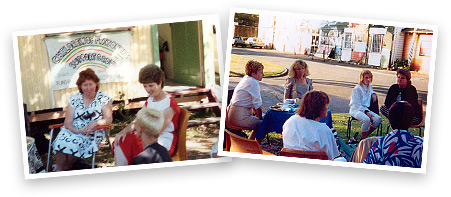
Our first place of our own was at the end of an old army hut in front of Reverse
Garbage, a place where recycled goods could be purchased very cheaply by everyone
from craft teachers to filmmakers. The Community Centre was (and still is) a warm,
friendly place, with a diverse range of services and activities on offer. Our building
was painted up by staff and volunteers on weekends.
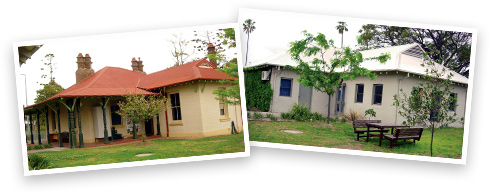
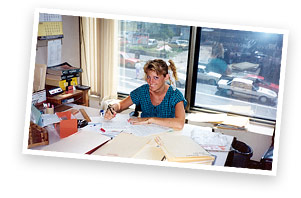 1984 1984
Station House, Central
We moved to Station House, part of the Sydney Central railway station building,
in Eddy Avenue. This office was much brighter and overlooked busy George Street.
Parking fines for staff and volunteers were commonplace, as were evacuations due
to ‘bomb threats’.
1982
In the beginning...
Child punishment is often the other side of the coin to parental imprisonment. This is one of those shadowy corners of the criminal
justice system seldom spotlighted. In our society, prisoners are
marginalised; their spouse and adult friends isolated and hidden;
while their children to all intents and purposes are invisible.
– Children of Imprisoned Parents Report , 1982
The Children of Imprisoned Parents Report was commissioned by the Family and
Children’s Services Agency in March 1982. Following its release, and in response
to its findings, SHINE for Kids was created as the Children of Prisoners’ Support
Group (COPSG). We operated from a room alongside what is now known as the
Community Restorative Centre (CRC), then based in Foster Street, Surry Hills. This
very old building was dark and gloomy and was also quite cramped. |